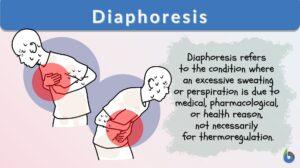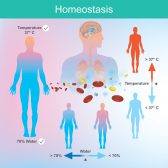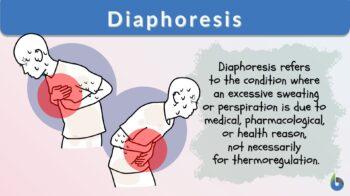
Diaphoresis
n., plural: diaphoreses
[ˌdaɪ.ə.fəˈɹiː.sɪs]
Definition: Excessive sweating or perspiration, especially due to a medical condition or the action of a diaphoretic drug
Table of Contents
What is Diaphoresis?
Diaphoresis is referred to excessive or profuse perspiration or sweating which may be due to associated medical conditions and might be induced as a side effect of a drug substance. Sweating is a natural phenomenon to regulate the body temperature however in diaphoresis sweating is not primarily induced for thermoregulation.
What is excessive sweating a sign of? Diaphoresis may actually be the manifestation of an underlying medical condition that might need urgent medical attention. Certain medicines also may induce diaphoresis.
So, what does it mean when a patient is diaphoretic? The definition of diaphoresis, in simple words, is the profuse sweating in a person when the environmental conditions or the physical activity may not be the cause of excessive sweating. A diaphoretic patient may experience sudden sweating spells wherein sweating profusely is seen in the patient, even when sitting in an air-conditioned room while watching TV. Night sweating or nocturnal diaphoresis wherein the patient breaks out in a sweat while in sleep exemplifies diaphoresis.
What happens during diaphoresis? The basic cause of excessive sweating in diaphoresis is not the overactivity of the sweat glands or malfunctioning of the nervous system, rather it is due to certain medicines or a medical condition that needs to be treated urgently. Hence, the treatment of the underlying medical condition will resolve the diaphoresis.
Sweating is a basic physiological phenomenon of the human body that helps in thermoregulation for the homeostatic regulation of the normal body temperature. The process of sweating involves the stimulation of cholinergic receptors that are present in the eccrine/sweat glands and their overstimulation results in excessive sweating. This excessive sweating due to overstimulation of sweat glands without any specific reason is referred to as hyperhidrosis.
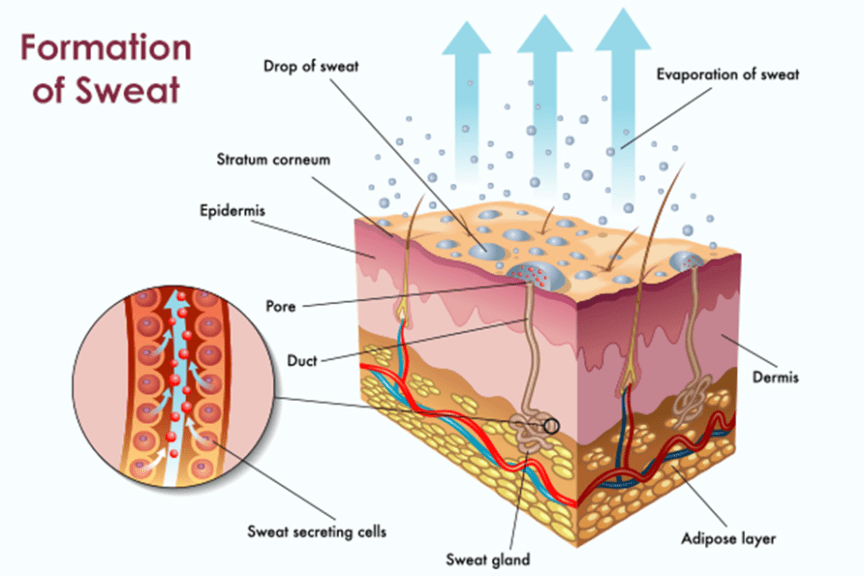
Watch this vid about medical diaphoresis:
Diaphoresis is the condition characterized by increased or excessive perspiration, especially due to a medical condition. It may also be caused by the action of a pharmacological drug or a plant-based agent promoting such a condition. These agents are called diaphoretics.
Etymology: The term diaphoresis came from the Latin diaphorēticus, from Greek diaphorētikós, meaning “promoting perspiration”.
Diaphoresis vs. Hyperhidrosis
Diaphoresis is different from hyperhidrosis. Diaphoresis does not occur due to overstimulation of the eccrine glands to regulate the body temperature; it is rather an indicator or adverse effect of a medicine or a medical condition.
Hyperhidrosis is of two types, primary focal hyperhidrosis and secondary generalized hyperhidrosis (the excessive sweating medical term is hyperhidrosis).
- Primary focal hyperhidrosis is profuse sweating that occurs without any specific cause and is seen in any specific part of the body only, for example, in armpits or scalp diaphoresis or excessive face sweating only.
- Secondary generalized hyperhidrosis is a medical condition or an adverse effect of medicine and sweating is not localized. It is seen throughout the entire body. Secondary generalized hyperhidrosis is also referred to as diaphoresis.
At this stage, let us understand the difference between primary hyperhidrosis and diaphoresis. (see table below)
Difference between Diaphoresis and (Primary) Hyperhidrosis | |
|---|---|
| Diaphoresis | Primary Hyperhidrosis |
| Define Diaphoresis: Profuse or excessive sweating that occurs due to an underlying medical condition or an adverse effect of a medicine | Define Primary Hyperhidrosis: Profuse or excessive sweating that occurs due without any specific reason or cause |
| Diaphoresis is also referred to as Secondary generalized hyperhidrosis | Primary focal hyperhidrosis may simply be referred to as hyperhidrosis |
| In secondary generalized hyperhidrosis, excessive sweating occurs throughout the body, i.e., generalized sweating | In primary focal hyperhidrosis, sweating occurs only in the specific regions of the body like the chest, hands, armpits, face or head i.e., localized sweating |
| Treatment of the underlying medical condition will resolve excessive diaphoresis | No treatment is currently available as the cause is not known. |
It may be due to:
| The cause behind is not exactly known, however, one of the probable causes can be genetics |
| Profuse diaphoresis is usually seen in adults | Observed in childhood or adolescence |
Data Source: Dr. Amita Joshi
Causes of Diaphoresis
Let us now understand: What causes severe diaphoresis? An underlying medical condition is the basic cause of diaphoresis in adults. Disturbances in the neuroendocrine and autonomic systems are primarily responsible for the impairment of the thermoregulatory system of the body.
Estrogen, adrenaline, glucose, serotonin, and calcitonin gene-related peptide are some of the primary neurochemicals or hormones that control the thermoregulatory system of the body. Hence, any diseased state or medicine that changes the levels of these neurochemicals or hormones can result in diaphoresis. (Figure 2)
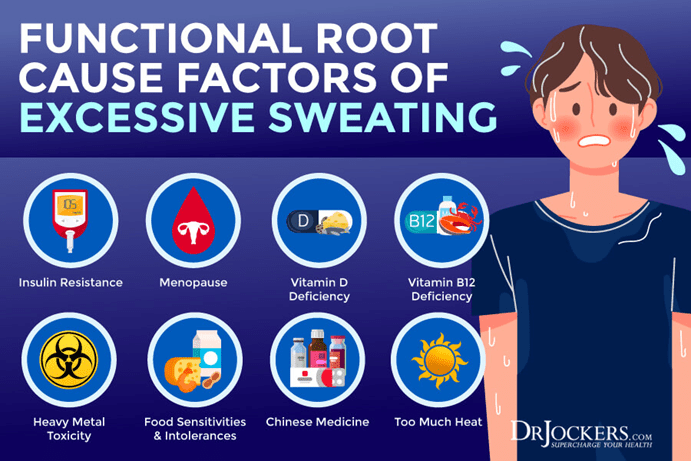
Pregnancy
Fluctuating hormone levels along with weight gain and metabolism are some of the reasons behind diaphoresis seen in pregnant women, especially during the first and third trimesters.
Menopause
Night sweats or hot flushes (or hot flashes) are one of the most common symptoms associated with menopause. Estrogen withdrawal during perimenopause and the menopausal phase is believed to be the main reason for the diaphoresis or night sweats. Change in the estrogen levels in women during menopause alters the thermal homeostasis resulting in profuse sweating. Diaphoresis usually starts in the perimenopausal phase due to the initiation of fluctuation in estrogen levels and continues to the period leading to menopause. However, in certain cases, it may even be seen in the post-menopausal phase. Hormone replacement therapy is useful in coping with night sweats.
Women have a larger number of sweat glands than men, however, it does not necessarily mean that women produce more sweat.
Diabetes
Excessive sweating has been manifested as one of the key symptoms of diabetes. Diabetes is an endocrinal disorder wherein thermoregulation of the body gets impaired. Sudden profuse sweating and nausea are commonly seen in diabetic patients, especially at night. Although both excessive sweating (diaphoresis or secondary hyperhidrosis) and lack of sweating (anhidrosis) are seen in diabetic patients, diaphoresis is more common in diabetics.
The main reason attributed to diaphoretic diabetes has been low blood sugar level (hypoglycaemia) and diabetes-induced neuronal damage or neuropathy. Low blood sugar levels in diabetics induce the sympathetic nervous system for the fight or flight response by increasing the levels of adrenaline hormone.
High levels of adrenaline hormone result in excessive sweating. While diabetic neuropathy causes nerve damage which results in abnormal neuronal control over thermoregulation.
Hyperthyroidism
Hyperthyroidism is an endocrinal hormonal disorder wherein thyroxine production is enhanced beyond normal levels. Thyroxine hormone is critical for the multiple metabolic processes of the body. As a result of which, overactive thyroid hormone, i.e., hyperthyroidism, increases or hastening up of various metabolic functions. In hyperthyroidism, overactivity of the sympathetic nervous system which results in increased production of adrenaline along with higher metabolic process results in abnormal sweating or diaphoresis.
Obesity
People with a BMI of over 30 are termed obese and such people often suffer from diaphoresis or excessive sweating. Obese people have a high amount of adipose tissue that does not allow heat dissipation from the body thereby inducing sweat glands to overwork, resulting in excessive sweating. Higher adipose tissue also increases the metabolic load of the body which further increases sweating. Also, certain studies indicate the role of adipose tissue on the production of estrogen levels which eventually can result in diaphoresis.
Heart attack
Sudden profuse sweating or diaphoresis and weakness are some of the most prominent clinical features of heart attack or angina. However, profuse or excessive sweating is often one of the most neglected symptoms indicatives of heart attack or angina. Extremely low blood supply to the heart induces heart attack, simultaneously this also induces the sympathetic nervous system for the fight or flight mode by increasing the production of adrenaline, which, in turn, increases the production by sweat glands is seen as diaphoresis. Excessive sweating along with severe chest pain and shortness of breath is an emergency and should be immediately given medical attention.
Other cardiac issues can also cause diaphoresis. Low blood pressure can result in reduced blood supply to the vital organs resulting in a shock. A diaphoretic shock can be manifested as low blood pressure sweating along with rapid breathing, blue skin, and a weak pulse. Similarly, high blood pressure can also result in multiple complications like high blood pressure profuse sweating, nervousness, and facial flushing. All these diaphoretic symptoms require immediate medical attention.
Some types of cancer
Patients of certain types of cancer namely, breast cancer, prostate cancer, leukaemia, non-Hodgkin lymphoma, Hodgkin lymphoma, etc. may exhibit excessive sweating. The exact cause of diaphoresis is not completely understood, however, it is presumed, that disruption in endocrinal hormones, chemotherapy, and certain tumor secretions may induce diaphoresis in cancer patients.
Anaphylaxis
Anaphylaxis is an acute immune response to certain substances which results in elevated levels of IgE in the body. Allergic reactions like atopic dermatitis are often associated with excessive sweating. Immune response induction by chemicals results in elevation of body temperature and hence to regulate the body temperature thermoregulatory system overworks and results in overproduction of sweat or diaphoresis.
Withdrawal from drugs or alcohol
Alcohol or drug withdrawal induces diaphoresis. Autonomic nervous system overactivity is seen in a patient undergoing withdrawal from drugs and alcohol, which may induce diaphoresis. Alcohol causes blood vessel dilation which results in the induction of sweating. Certain drugs like heroin raise the body temperature and hence to regulate the body temperature, sweat production is initiated, which is seen as diaphoresis.
Medications
Drugs that affect the hypothalamus or thermoregulatory center of the body, directly or indirectly exhibit diaphoresis as one of the side effects. Drugs that stimulate or affect the production of adrenaline directly or indirectly or the medicines that inhibit the production of the enzyme acetylcholinesterase induce the sweat glands to produce more sweat. Some of these drugs are:
- Certain medications for psychiatric disorders: selective serotonin reuptake inhibitors (e.g., citalopram), antipsychotics (e.g., clozapine, haloperidol), and tricyclic antidepressants (e.g., amitriptyline).
- Medications used for Parkinson’s disease and dementia: acetylcholinesterase inhibitors (e.g., benztropine, donepezil)
- Pain relief medications: opioids (e.g., oxycodone, fentanyl, morphine, and tramadol) and some non-steroidal anti-inflammatory drugs (e.g., naproxen and celecoxib)
- Certain antibiotics: cephalosporins (e.g., cefuroxime), ciprofloxacin, acyclovir, etc.
- Endocrinal medicines: insulin, glipizide, corticosteroids, and thyroid medicines.
Treatment
The basic treatment approach for resolving diaphoresis is the treatment of the underlying cause or the disease condition. In the majority of the cases, treatment of the root cause of disease or substance alleviates the problem of diaphoresis. However, certain treatment modalities can be used for the treatment of diaphoretic skin (Figure 3).
- Using a prescription-strength topical aluminum chloride-containing antiperspirant. These antiperspirants block the secretory duct of the sweat gland (eccrine gland) or exert their astringent effect on the sweat glands. These antiperspirants can be used in the soles, palms, and axillae.
- Use of oral anticholinergic agents, agents that inhibit the activity of cholinergic receptors seems to be a logical choice of agent. The cholinergic system is involved in signaling the production of sweat, hence inhibition of the cholinergic system reduces the perspiration. Some of the anticholinergic agents used for diaphoresis include glycopyrrolate or oxybutynin. However, these medications may exhibit side effects like dry mouth, blurred vision, and constipation.
- Iontophoresis is a very successful approach to resolving diaphoresis especially when it is localized to a certain area only. Iontophoresis involves the application of a small amount of low-voltage electric current into the intact skin with the passage of electrically charged ions. As a result of this, sweat glands are temporarily blocked thereby reducing sweating considerably. This treatment approach is very successful when applied to the plantar region and on the palms.
- The use of Botulinum toxin injections is an FDA-approved treatment for axillary hyperhidrosis. Botulinum toxin acts by blocking the release of neurochemical, acetylcholine thereby temporarily cessing the production by the sweat glands.
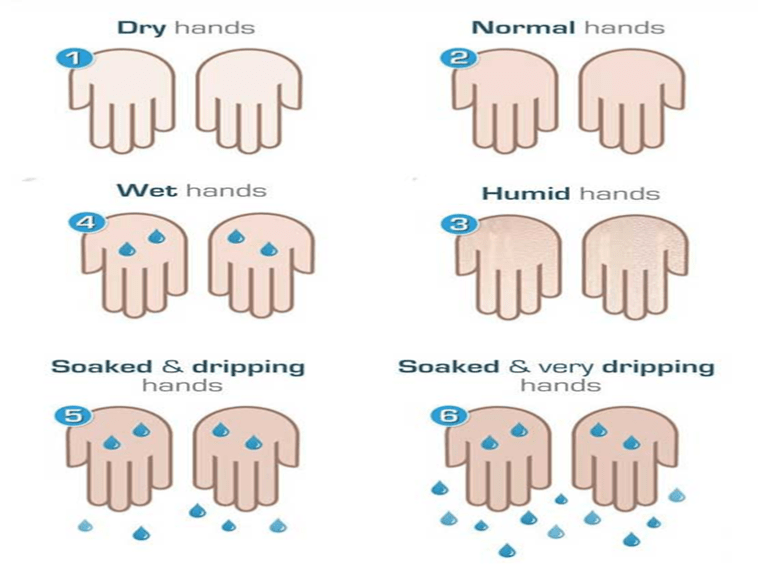
In comparison to plasma, sweat is hypotonic. That also means that sodium and chloride concentration in sweat is less than that of the blood/plasma.
Diaphoretics vs. sudorifics
Diaphoretics, which refer to any agents promoting diaphoresis, are also sometimes referred to as sudorifics. However, diaphoretics are, in a stricter sense, more associated with the insensible type of perspiration in contrast to sudorifics that are more associated with the sensible type. Diaphoretics promote insensible perspiration. This means the individual is usually unaware because the sweating is not profuse or intensely felt. Sudorifics, in contrast, are def promoters of sensible perspiration. The sweating is so profuse that sweat drops run down across the body surface. Hence, the individual is much more aware of such excessive sweating caused by sudorifics. (Cram.com, 2020)
Examples of diaphoretics
Some of the plant-based (herb) diaphoretics are as follows: (Brunton, 2020) Pleurisy root, Horehound herb, Hyssop herb, Sage leaves, Bergamont leaves, Blessed Thistle, Lemon Balm, Burdock root, Tansy, Chamomile, Anise seed, Elderflowers, Yarrow, and Pennyroyal herb.
Prevention
Sweating is a natural body phenomenon, hence prevention of diaphoresis is not possible. Treatment of the root cause of the diaphoresis is the only solution to this condition. However, certain lifestyle changes can be made to cope with diaphoresis, like:
- Avoiding food and drink items like caffeine that can induce sweating
- Wearing breathable, loose-fitting cotton clothes
- Using topical antiperspirants or absorbent powder before sleeping
- Drinking a sufficient amount of water
When to See a Doctor for Diaphoresis
If a person is having constant sweating, it can actually be an indication of the associated disease hence if one starts to have sudden excessive sweating without any provocative factor (like heat, or physical exertion or activity), it is advisable to contact a doctor to assess the medical condition.
Diaphoresis with breathlessness, chest pain, and feeling clammy could be a sign of possible angina or heart attack and needs immediate medical attention.
Similarly, diaphoresis with redness of the skin, breathlessness, and severe itching could be a sign of anaphylaxis, which is an emergency medical condition.
Caution: The information contained here is for educational purposes only. It should not replace medical advice. Do not self-medicate with over-the-counter medications. Consult with a medical professional.
Answer the quiz below to check what you have learned so far about diaphoresis.
References
- Cram.com. (2020). diaphoretics &sudorifics Flashcards. Cram.Com. https://www.cram.com/flashcards/diaphoretics-sudorifics-496053
- Brunton, T. L. (2020). A Text-Book Of Pharmacology, Therapeutics And Materia Medica. Chestofbooks.Com. https://chestofbooks.com/health/materia-medica-drugs/Pharmacology-Therapeutics-Drugs/index.html#.VCppF-mSySo
- Atkins, J. L., & Butler, P. E. (2002). Hyperhidrosis: a review of current management. Plastic and reconstructive surgery, 110(1), 222-228.
- Schlereth, T., Dieterich, M., & Birklein, F. (2009). Hyperhidrosis–causes and treatment of enhanced sweating. Deutsches Arzteblatt international, 106(3), 32–37. https://doi.org/10.3238/arztebl.2009.0032
- Liu, Z. (2010). Diaphoresis. In Essentials of Chinese Medicine (pp. 1189-1196). Springer, London.
- Deecher, D. C., & Dorries, K. (2007). Understanding the pathophysiology of vasomotor symptoms (hot flushes and night sweats) that occur in perimenopause, menopause, and postmenopause life stages. Archives of women’s mental health, 10(6), 247–257. https://doi.org/10.1007/s00737-007-0209-5
©BiologyOnline. Content provided and moderated by BiologyOnline Editors.

